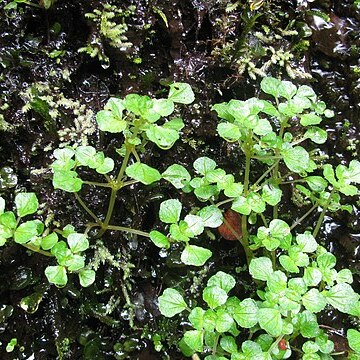Herbs weak, often clumped, glabrous, monoecious. Stems reddish, simple or branched, slender, 3-20 cm tall, 1-2 mm in diam., succulent; lower internodes long, upper ones very short. Stipules soon deciduous, triangular, minute, ca. 0.5 mm, membranous; petiole slender, subequal in length, 3-20 mm; leaf blade conspicuously purplish punctate, particularly abaxially, suborbicular, rhombic-orbicular, or deltoid-ovate, subequal in size, 3.5-21 × 3-23 mm, membranous, lateral veins indistinct, cystoliths linear, often regularly transverse, conspicuous abaxially, base cuneate or broadly cuneate, rarely subrounded, margin entire or weakly sinuate-crenate distally, apex obtuse, rounded, sometimes subacute. Inflorescences sometimes androgynous, often with male and female inflorescences borne in same axil, compactly cymose-capitate, subglobose; male ones 0.3-1 cm overall, peduncle 0.15-0.7 cm; female inflorescence 0.2-0.6 cm, peduncle 1-4 mm or almost absent. Male flower pedicellate, ca. 0.8 mm; perianth lobes ovate, connate 1/2 of length, apex acute; stamens 4; rudimentary ovary minute. Female flowers light green, pedicellate; perianth lobes 2, very unequal, abaxial lobe cymbiform, as long as fruit, thickened in fruit, adaxial lobe triangular-ovate, ca. 1/5 as long as abaxial lobe, membranous; staminodes oblong, ca. 1/2 length of fruit, but abortive ones much longer. Achene light brownish, ovoid, ca. 0.5 mm, slightly compressed, oblique at apex, smooth or spinulose-verrucose. Fl. Apr-Jul, fr. Jun-Aug.
More
Short, creeping herb to c. 10 cm high, monoecious, glabrous. Leaves: lamina orbicular, entire to crenulate, cuneate at base, 1–5 mm long, with many transverse, linear cystoliths, 3-veined; petiole 1–6 mm long. Inflorescence bisexual, condensed, often clustered in leaf axils, subtended by several bracts; peduncle short. Flowers minute. Male flowers 4-merous; perianth c. 0.6 mm long, cup-shaped, splitting into 4 segments, fused at base. Female flowers c. 0.3 mm long, with 3 ovate perianth segments, one twice as large as the others and concave; ovary ovoid; stigma penicillate, Achenes ovoid, oblique, c. 0.5 mm long, brown.

